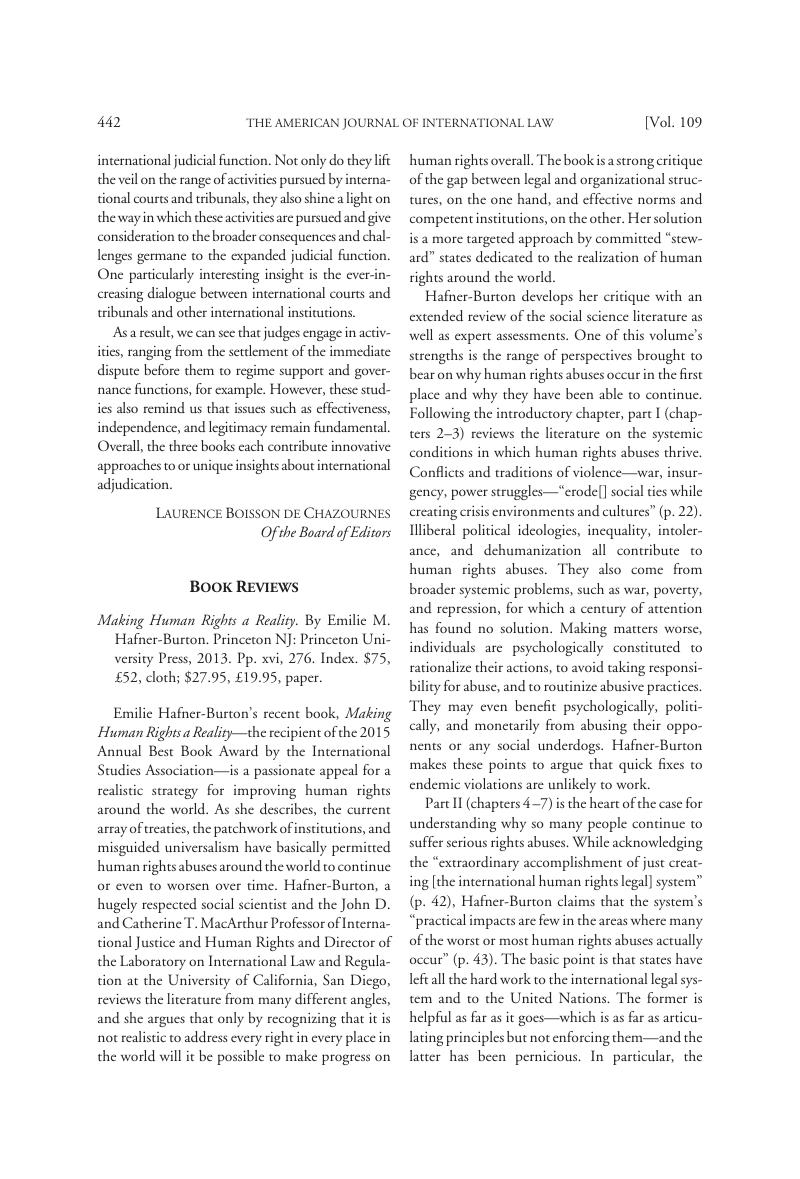No CrossRef data available.
Published online by Cambridge University Press: 20 January 2017

1 The “International Bill of Rights” encompasses the rights set forth in the Universal Declaration of Human Rights, GA Res. 217A (III), UN GAOR, 3d Sess., Resolutions, at 71, UN Doc. A/810 (1948); the International Covenant on Civil and Political Rights, Dec. 16, 1966, 999 UNTS 171; and the International Covenant on Economic, Social and Cultural Rights, Dec. 16, 1966, 993 UNTS 3.
2 Ryan Goodman & Derek Jinks, Socializing States:Promoting Human Rights Through International Law (2013).
3 Kathryn Sikkink, The Justice Cascade: How Human Rights Prosecutions Are Changing World Politics (2011); Beth A. Simmons, Mobilizing for Human Rights: International Law in Domestic Politics (2009).
4 Convention Against Torture and Other Cruel, Inhuman or Degrading Treatment or Punishment, Dec. 10, 1984, S. Treaty Doc. No. 100-20 (1988), 1465 UNTS 113.
5 Cosette Creamer & Beth A.Simmons, Do Self-Reporting Regimes Matter? Evidence from the Convention Against Torture (Feb. 11, 2015) (draft article), available at http://projects.iq.harvard.edu/files/wcfia/files/creamersimmons_isa2015.pdf.
6 The classic study on the power of international organizations to socialize actors including states is Johnston, Alastair Iain, Treating International Institutions as Social Environments, 45 Int’l Stud. Q. 487 (2001)CrossRefGoogle Scholar. For a recent survey study exploring and supporting this link, see Natalia Saltalamacchia, Three Decades of Socialization Later, Mexicans View “Human Rights“ as Their Own, Open Democracy (Jan. 2, 2015), at https://www.opendemocracy.net/openglobalrights/natalia-saltalamacchia/three-decades-of-socialization-later-mexicans-view-%E2%80%9Chuman-ri.
7 Universal Declaration of Human Rights, supra note 1.
8 Hathaway, Oona A., Do Human Rights Treaties Make a Difference?, 111 Yale L.J. 1935 (2002)CrossRefGoogle Scholar.
9 See U.S. Dep’t of State, Bureau of Democracy, Human Rights and Labor, The Taliban’s War Against Women: Report on the Taliban’s War Against Women (Nov. 17, 2001), at http://www.state.gov/j/drl/rls/6185.htm.
10 Jack Donnelly, Universal Rights in Theory and Practice 6 (1989).
13 These tallies are based on use of the Berkman Center’s “Media Cloud” tool, https://cyber.law.harvard.edu/research/mediacloud.
14 A search in early 2015 of the HeinOnline database, http://www.heinonline.org, provided these findings.
15 Eric A. Posner, The Twilight of Human Rights Law (2014).
16 Samuel Moyn, The Last Utopia:Human Rights in History 44–83 (2010).
17 Stephen Hopgood, The Endtimes of Human Rights (2013).